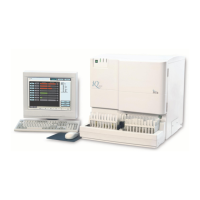Iris Diagnostics, a Division of Iris International, Inc.
iQ
®
200 Sprint™ (2G)Automated Urine Microscopy Analyzer Service Manual 300-4949 Rev A 01/2005 5-12
5. Service Application Software
Status Bar
Check this item to show the status bar. Uncheck it to hide the status bar.
Polling
One of the following values can be chosen:
•
Off – Turn polling off. When the current group of query messages
completes, the link status will show “Idle” and remain there.
Polling will not continue until something besides Polling: Off is
chosen. Some menu items cannot be selected unless polling is
turned off.
•
Slow – Polling is turned on. There does not seem to be any
difference between Slow, Medium and Fast.
•
Medium – Polling is turned on. There does not seem to be any
difference between Slow, Medium and Fast.
•
Fast – Polling is turned on. There does not seem to be any
difference between Slow, Medium and Fast.
Video
Selecting this item displays the live video window (ViewPXD), or brings it
to the top if it is already being displayed.
Record Video Statistics
This command gets the video statistics from the live video window and
appends them to a data file. If the live video window has not been started,
this command starts it and pauses a few seconds, providing time for the
live video window to initialize. The statistics – “Avg”, “Flicker” and “Var” –
are appended to C:\iris2k1\reports\VideoStatistics.csv. Comma separated
value files (.csv) are commonly used to exchange data with data
manipulation applications such as Excel.
Terminal
Displays the Terminal window. This item is only enabled when the Polling
is off and the link status is “Idle”.
The Terminal window consists of a scrolling list of message traffic
between the Service program and the analyzer control system, an area in
which to type new messages, a Send button to send the new message,
and OK/Cancel buttons to close the Terminal window.
The Terminal Window, an advanced feature, allows messages to be
typed in directly and their replies to be displayed.
Tip: The Terminal Window should only be used by very advanced users
or under the direct supervision of very advanced users.

